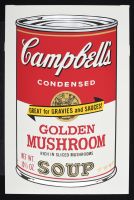Campbell's Soup II Golden Mushroom No.62
Warhol fine art, Golden Mushroom
, from the Campbell's Soup II portfolio, is a screenprint created by Andy Warhol in 1969. It is a well-known image from the Pop Art movement, which sought to blur the lines between commercial and fine art by taking everyday, mundane objects and elevating them to the status of art. The print depicts a can of Campbell's "Golden Mushroom" condensed soup, with a yellow banner across the center that reads "GREAT for GRAVIES and SAUCES!".
Warhol's first series of Campbell's soup cans, created in 1962, featured 32 hand-painted canvases, one for each soup flavor the company sold at the time. The 1969 Campbell's Soup II portfolio, which includes the Golden Mushroom can, was created using the silkscreen process, a technique rooted in advertising that allowed Warhol to further explore themes of mass production and repetition. He was fascinated by the uniformity of consumer products and famously said, "I used to drink it.Golden Mushroom, from the Campbell's Soup II portfolio, is a screenprint by Andy Warhol created in 1969. This work is a notable example of the Pop Art movement, which transformed everyday consumer products into fine art. The image depicts a can of Campbell's "Golden Mushroom" condensed soup, including a yellow banner with the slogan "GREAT for GRAVIES and SAUCES!".
Warhol's initial series of Campbell's soup can paintings was created in 1962, featuring 32 hand-painted canvases. The Campbell's Soup II portfolio, created seven years later, was made using a silkscreen process, which allowed for a more mechanical and precise reproduction that mirrored the industrial nature of commercial products. This series also introduced more visual variety by incorporating new fonts and slogans.
, from the Campbell's Soup II portfolio, is a screenprint created by Andy Warhol in 1969. It is a well-known image from the Pop Art movement, which sought to blur the lines between commercial and fine art by taking everyday, mundane objects and elevating them to the status of art. The print depicts a can of Campbell's "Golden Mushroom" condensed soup, with a yellow banner across the center that reads "GREAT for GRAVIES and SAUCES!".
Warhol's first series of Campbell's soup cans, created in 1962, featured 32 hand-painted canvases, one for each soup flavor the company sold at the time. The 1969 Campbell's Soup II portfolio, which includes the Golden Mushroom can, was created using the silkscreen process, a technique rooted in advertising that allowed Warhol to further explore themes of mass production and repetition. He was fascinated by the uniformity of consumer products and famously said, "I used to drink it.Golden Mushroom, from the Campbell's Soup II portfolio, is a screenprint by Andy Warhol created in 1969. This work is a notable example of the Pop Art movement, which transformed everyday consumer products into fine art. The image depicts a can of Campbell's "Golden Mushroom" condensed soup, including a yellow banner with the slogan "GREAT for GRAVIES and SAUCES!".
Warhol's initial series of Campbell's soup can paintings was created in 1962, featuring 32 hand-painted canvases. The Campbell's Soup II portfolio, created seven years later, was made using a silkscreen process, which allowed for a more mechanical and precise reproduction that mirrored the industrial nature of commercial products. This series also introduced more visual variety by incorporating new fonts and slogans.
Disclaimer
The object and/or subject of this report is private property. This page is for informational purposes only. Unless clearly stated otherwise, all conservation and restoration has been performed by Poster Mountain (PM) or Los Angeles Paper Group (LAPG)I) PM-LAPG has not knowingly withheld any significant information from its evaluation report and to the best of its knowledge all statements and evaluations in this report are true and correct.
II) PM-LAPG stated in the Evaluation Report its own personal, unbiased and professional analysis, opinions and conclusions, which are subject to the assumptions and limited conditions in this evaluation report as set forth hereinabove.
III) PM-LAPG has no present or prospective interests in the property which is the subject matter of this report and it has no present or prospective personal interests or bias with respect to the participants in this matter.
IV) PM-LAPG and its employment and/or compensation for performing this evaluation or any future anticipated evaluation was not conditioned on any agreement or understanding, written or otherwise, that it would report (or present analysis in support) as predetermined specific authenticity, a predetermined evaluation that favors the cause of any party or the attainment of any specific result or occurrence of a specific subsequent event, such as value or marketability.
V) PM-LAPG prepared all opinions and conclusions about the subject property that were set forth in this Evaluation Report. If it has relied on significant evaluation assistance from any individual or individuals in the performance of this evaluation or the appropriation of this evaluation report, PM-LAPG has named such individuals and disclosed the specific task performed in this evaluation report. PM-LAPG certifies that any individual so named is qualified to the same extent as PM to perform the task. PM-LAPG has not authorized anyone to make a change to any item in this evaluation report, therefore, any change made to this evaluation is unauthorized and PM-LAPG will not take responsibility for it.
VI) The Client may not disclose or distribute this Evaluation Report to any potential purchasers of the subject property without first obtaining PM-LAPG's prior written consent. This consent must be obtained before this evaluation report may be disclosed or distributed to any other party, including, but not limited to, the public through advertising, public relations, news, sales, or other media.

